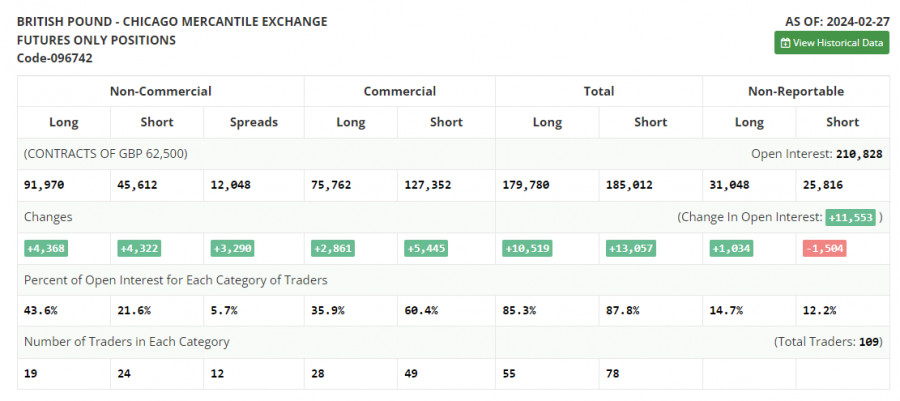
Yesterday, traders received several market signals to enter the market. Let's take a look at the 5-minute chart and see what happened. Earlier, I paid attention to the level of 1.2678 to decide when to enter the market. A rise and a false breakdown led to a 15-pip drop in the pound, but then the pressure on the pair weakened. In the second half of the day, similar active actions of sellers near 1.2678 led to another sell entry point, which resulted in a decline by the same 15 pips, after which the demand for the pound sterling returned.

Conditions for opening long positions on GBP/USD:
Let us first find out what happened in the futures market. According to the COT report (Commitment of Traders) for February 27, the number of both short and long positions increased. The latest inflation data and the statements of the Bank of England's officials that rates could be lowered even if inflation fails to reach the 2.0% target have become of secondary importance. Now, a lot will depend on the position of the Federal Reserve. US policymakers are concerned about the fact that inflation is no longer coming down as much as they would like, which could lengthen the cycle of high interest rates until late summer this year. This all is capping the pound's appreciation, thus boosting the US dollar. The latest COT report unveiled that long non-commercial positions rose by 4,368 to 91,970, while short non-commercial positions jumped by 4,322 to 45,612. As a result, the spread between long and short positions increased by 3,290.

Today, we are expecting some rather important data for the UK economy. We are talking about the UK services PMI and composite PMI. The indicators' growth will help to level out the problems observed in the manufacturing sector, which will have a positive effect on the British pound. In case of weak figures, it will be another call to the Bank of England that it is time to stop raising rates. If the pound reacts to the data with a fall, the development of a downward correction is not excluded, although buyers will do everything possible to prevent it from going below the nearest support at 1.2667, where I am going to act. A false breakdown will give an entry point with a target at the resistance level of 1.2704, formed late yesterday. A breakout and downward test of this range will strengthen the chance for further GBP/USD recovery, which will allow traders to open new buy orders, thus pushing the price to 1.2741. If the pair exceeds this range, we may see a breakout to 1.2769, where I am going to take a profit. In case of a drop in GBP/USD and the absence of buyers at 1.2667, sellers will get a chance to push the pound down to 1.2536. It will be possible to buy there only after a false breakdown. Traders may also open long positions on GBP/USD just after a rebound from 1.2600, expecting a rise of 30–35 pips within the day.
Conditions for opening short positions on GBP/USD:
Bears have every chance to regain the initiative. This requires weak data, which, together with a false breakdown near resistance at 1.2704, will give an entry point for short positions counting on a decline and a test of support at 1.2667. A breakout and an upward test of this range will increase the pressure on the pair, giving bears an advantage and another entry point for selling with the target of updating 1.2636, where I expect more actions from buyers. A further target is located at the low of 1.2600, where I will take profits. If GBP/USD advances and bears fail to be active at 1.2704, bulls will strengthen their positions, which will lead to the development of a new uptrend and a rise to the next resistance at 1.2741. There, it will be possible to go short only after a false breakdown. Traders may open short orders from 1.2769 in the expectation of a decline of 30-35 pips within the day.
Indicators' signals
Moving averages
The instrument is trading above the 30 and 50-day moving averages, which points to a possible rise in the pound sterling.
Note: The period and prices of the moving averages are considered by the analyst on the 1-hour chart and differ from the general definition of classic daily moving averages on the daily chart.
Bollinger Bands
In case of a rise, the upper limit of the indicator seen at 1.2704 will act as resistance. If the pair declines, the lower limit, located at 1.2667, will act as support.
Description of indicators
Moving average (moving average, determines the current trend by smoothing out volatility and noise). Period 50. It is marked yellow on the chart. Moving average (moving average, determines the current trend by smoothing out volatility and noise). Period 30. It is marked green on the chart. MACD indicator (Moving Average Convergence/Divergence—convergence/divergence of moving averages) Quick EMA period 12. Slow EMA period to 26. SMA period 9 Bollinger Bands (Bollinger Bands). Period 20 Non-commercial speculative traders, such as individual traders, hedge funds, and large institutions that use the futures market for speculative purposes and meet certain requirements. Long non-commercial positions represent the total long open position of non-commercial traders. Short non-commercial positions represent the total short open position of non-commercial traders. Total non-commercial net position is the difference between short and long positions of non-commercial traders.